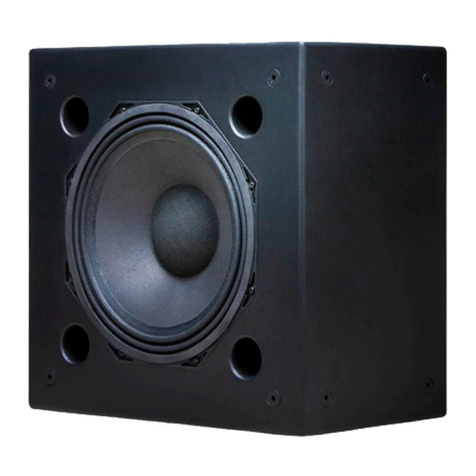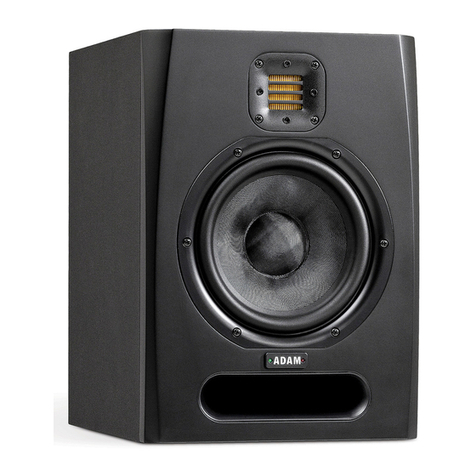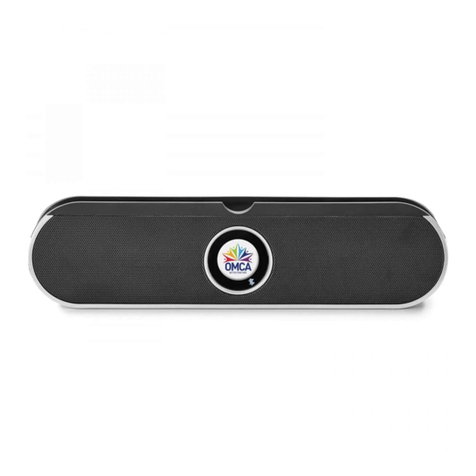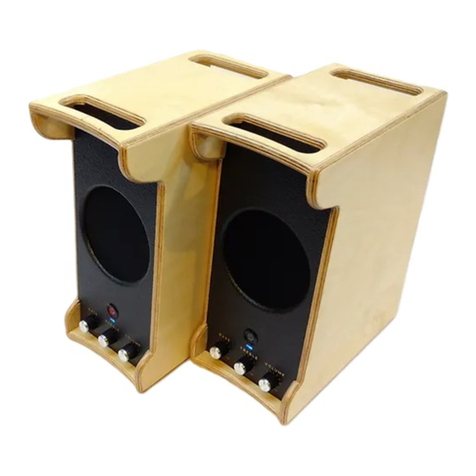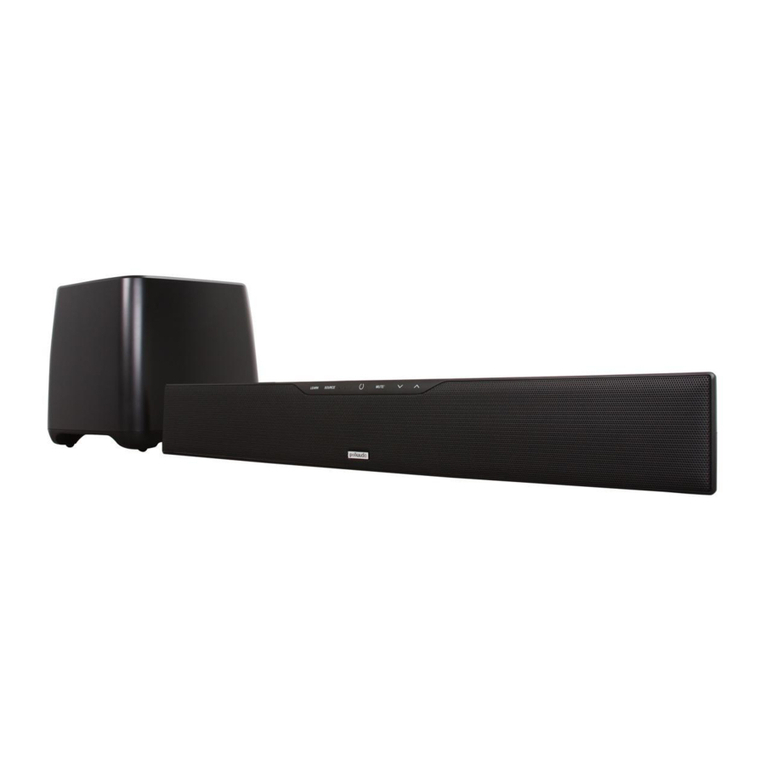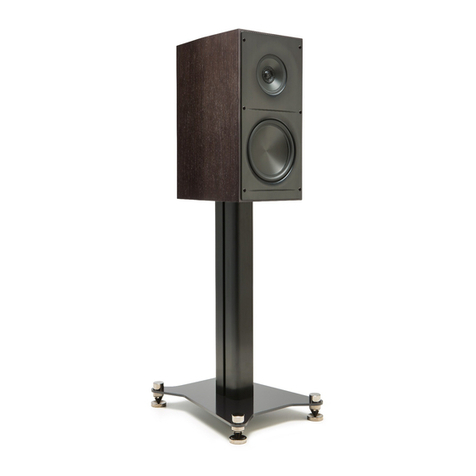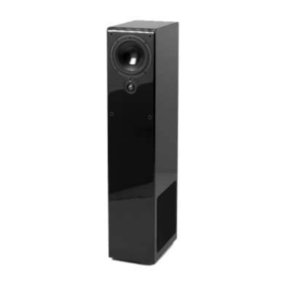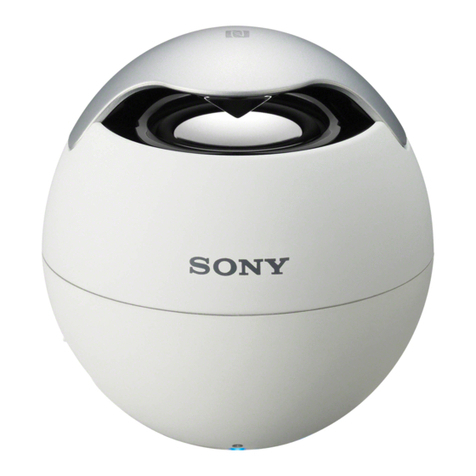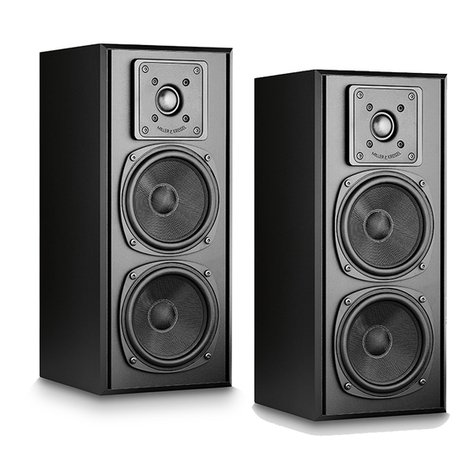INDY AUDIO LABS Acurus ASPEQT Assembly instructions

All models
Version 1.21
(Revision 20210314 – Initial Production Version)

Manufactured under license from Dolby Laboratories. Dolby, Dolby Atmos, Dolby Audio,
Dolby Digital Plus, Pro Logic and the double-D symbol are trademarks of Dolby Laboratories.
For DTS patents, see http://patents.dts.com

CAUTION:
RISK OF ELECTRIC SHOCK!
DO NOT OPEN!
1. Read Instructions – All safety and operating instructions should be
read before operating the device.
2. Retain Instructions –The safety and operating instructions should be
retained for future reference.
3. Heed Warnings – All warnings on the device and in the operating
instructions should be adhered to.
4. Follow instructions – All operating and safety instructions should
be followed.
5. Attachments – Do not use attachments not recommended by the
product manufacturer as they may cause hazards.
6. Water and Moisture – Do not use this product near water (for
example, near a bath tub, wash bowl, kitchen sink, or laundry tub;
in a wet basement; or near a swimming pool; and the like).
7. Ventilation – Slots and openings in the cabinet are provided for
ventilation and to ensure reliable operation of the product and to
protect it from overheating, and these openings must not be blocked
or covered. The openings should never be blocked by placing the
product on a bed, sofa, rug, or other similar surface. This product
should not be placed in a built-in installation such as a bookcase
or rack unless proper ventilation is provided or the manufacturer’s
instructions have been adhered to.
8. Heat – This product should be situated away from heat sources
such as radiators, heat registers, stoves, or other products that
produce heat.
9. Power Sources – This product should be operated only from the
type of power source indicated on the marking label. If you are not
sure of the type of power supply in your home, consult with your
product dealer or the local power company. For products intended
to operate from battery power, or other sources, refer to the
operating instructions.
10. Grounding – This product is equipped with a three-wire grounding-
type plug, a plug having a third (grounding) pin. This plug will only
fit into a grounding-type power outlet. This is a safety feature. If you
are unable to insert the plug into the outlet, contact your electrician
to replace your obsolete outlet. Do not defeat the safety purpose of
the grounding-type plug.
11. Power Cord Protection – Power supply cords should be routed
so that they are not likely to be walked on or pinched by items
placed upon or against them, paying particular attention to cords
at plugs, convenience receptacles, and the point where they exit
from the product.
12. Overloading – Do not overload wall outlets, extension cords, or
integral convenience receptacles as this can result in a risk of fire
or electrical shock.
13. Lightning and Periods of Non-Use – For added protection for this
product during a lightning storm, or when it is left unattended and
unused for long periods of time, unplug it from the wall outlet and
disconnect the antenna or cable system. This will prevent damage to
the product due to lightning and powerline surges.
14. Cleaning – Unplug this product from the wall outlet before cleaning. Do
not use liquid cleaners or aerosol cleaners. Use a damp cloth for
cleaning.
15. Object and Liquid Entry – Never push objects of any kind into this
product through openings as they may touch dangerous voltage points
or short-out parts that could result in a fire or electric shock. Never spill
liquid of any kind on the product.
16. Damage Requiring Service – Unplug this product from the wall outlet
and refer servicing to qualified service personnel under the following
conditions:
a) When the power supply cord or plug is damaged,
b) If liquid has been spilled, or objects have fallen into the product,
c) If the product has been exposed to rain or water,
d) If the product does not operate normally by following the operating
instructions. Adjust only those controls that are covered by the
operating instructions as an improper adjustment of other controls may
result in damage and often will require extensive work by a qualified
technician to restore the product to its normal operation,
e) If the product has been dropped or damaged in any way, or
f) When the product exhibits a distinct change in performance – this
indicates a need for service.
17. Replacement Parts – When replacement parts are required, be sure
the service technician has used replacement parts specified by the
manufacturer or that have the same characteristics as the original
parts. Unauthorized substitutions may result in fire, electric shock, or
other hazards.
18. Safety Check – Upon completion of any service or repairs to this
product, ask the service technician to perform safety checks to
determine that the product is in proper operating condition.
19. Servicing – Do not attempt to service this product yourself as opening
or removing covers may expose you to dangerous voltage or other
hazards. Refer all servicing to qualified service personnel. If this unit is
purchased outside of the U.S., please contact your local dealer or
distributor for service center information. If purchased inside the U.S.
and dealer service is not available, contact Acurus Customer Service
for a return authorization (RA) number before shipping. For further
service information, contact:
ACURUS CUSTOMER SERVICE
phone: 1-866-781-7284
Email: [email protected]
5225 EXPLORATION DRIVE
INDIANAPOLIS, IN 46241
CAUTION! To reduce the risk of electric shock and fire, do not remove the cover or back plate of the device
enclosure. There are no user serviceable parts inside. Refer servicing to an Acurus authorized service center.
CAUTION! The international symbol of a lightning bolt inside a triangle is intended to alert the user to
uninsulated “dangerous voltage” within the device enclosure. The international symbol of an exclamation
point inside a triangle is intended to alert the user to the presence of important operating, maintenance and
servicing information in the manual accompanying the device.
WARNING! To reduce the risk of fire or electrical shock, do not expose this equipment to rain or moisture.
IMPORTANT SAFETY INSTRUCTIONS

Important Safety Instructions Contents Congratulations
Unpacking
Carton
Package Contents
Register your Product
Record your Unit information
ASPEQT design philosophy
Acoustics and Measurements
Hardware Architecture
Software
ASPEQT Kit Contents
HDMI Stick
Mic Box
Mic Stands
USB Mics
Carry Case
DB-9 to USB cable
Preliminary Setup Steps
System Setup Pre-requisites
System Setup Overview
Setting Up ASPEQT
HDMI Stick
Mic Box
Setting ASPEQT Variables
Room Setup
Microphone Setup
Parameter Setup
Making Measurements
Initial Steps
Loudspeaker Tests
Test Sequence Outline
ASPEQT Results
Results Report (On-Screen)
Curve View Overlay Options
Parametric EQ Filters
PEQ Technical Notes
Results Report (Print-Ready)
Finishing A Session
Updating Firmware
Problem Resolution
Product Specifications
Electrical
Physical

Congratulations on your purchase of the ASPEQT
Automatic Speaker Parameter and EQ Tool from Indy Audio
Labs. ASPEQT is the most efficient and effective way to
tune and optimize an Acurus pre-amp processor for its
environment. The ASPEQT system represents a revolution
in room tuning when it comes to ease of use, repeatability
and convenience. Years of dedicated research, extensive
testing, and engineering refinement went into the creation of
this product.
Since 1993, Acurus has been delivering high-value, high-
performance electronics. Just like the first Acurus products
to roll off the assembly line more than 25 years ago, this
ASPEQT system was designed, hand-assembled and tested
with pride by engineers, technicians and skilled assemblers
in the United States of America. You should expect years of
trouble-free operation from your product investment.
unpacking
Carton
Using a sharp object such as a knife or scissors, carefully
open the outer single-walled (brown) shipping carton and
remove the contents.
Package Contents
Inside the ASPEQT shipping box you should find the
following:
1. ASPEQT Microphone Hard Shell Case
2. 4x Measurement Microphones
3. 4x 15-foot USB Microphone Cables
4. 4x Retractable Boom Microphone Stands
5. Microphone Stand Carrying Case with Shoulder
Strap
6. HDMI Stick and Power Supply
7. Mic Box and Power Supply
8. DB9 to RS-232 cable
9. 12-inch HDMI male-to-female Adapter Cable
10. ASPEQT User Guide
11. Warranty Registration Card
In the unlikely event of any of the above items missing,
immediately contact your dealer or Acurus Customer
Service:
ACURUS CUSTOMER SERVICE
phone: 1-866-781-7284
email: support@acurusav.com
5225 EXPLORATION DRIVE
INDIANAPOLIS, IN 46241
Register your Product
In order to validate your purchase and qualify for the full five
(5) year parts and labor manufacturer’s warranty on your
new Acurus product, you must have purchased it from an
authorized Acurus retailer AND you must return the included
warranty card completely filled out within 30 days of
purchase.
Record your Unit Information
For future reference, we recommend recording your product
information here:
Date of Purchase ____________________________________
Date Registered _____________________________________

The ASPEQT system represents the marriage of several
revolutionary and proprietary concepts in professional
acoustics test and measurement systems invented by Indy
Audio Labs.
Acoustics and Measurements
The ASPEQT system is based on years of experience in
tuning sound systems for listeners in varied environments.
Multi-mic approach: Many systems, especially lower-cost
AVRs and processors, use a single microphone located at
the main listening position to measure room response. The
ASPEQT system incorporates four microphones placed in a
unique pattern that enables substantially better results over a
larger listening area. Spatial resolution is improved vs the
single mic approach. Larger spaces can be tuned with fewer
microphone positioning iterations.
Adjustable Frequency Range: Many systems attempt to over-
equalize high frequency response which can result in poor
high-frequency balance and corruption of desirable tonal
characteristics of HF drivers, especially horn-loaded drivers.
The ASPEQT system allows the user to limit the frequency
range of EQ adjustment. This enables the installer to place
heavier weighting on low-frequency correction (below, say,
500 Hz) with a resulting superior bass response and
maintenance of the character and tonal characteristics of the
HF drivers in the main speakers.
Customizable Parameters: The relative loudness and
response shape of a system is not defined by an absolute
standard but rather guided by standards and tailored by the
installer to the tastes and listening preferences of the
homeowner. ASPEQT incorporates variables such as
reference level adjustment and target EQ curve selection so
that the system can be optimized not only for the room
acoustics but also the homeowners listening preferences.
Ability to Manually Fine-Tune: As powerful as the multiple
signal processors in the ASPEQT system are, the human ear
and brain are sometimes able to discriminate fine details that
are currently impossible for an automatic system to measure.
As a result, the installer is left with the freedom to choose to
further optimize EQ and other parameters following ASPEQT
room tuning.
Hardware Architecture
The ASPEQT system consists of hardware specifically
chosen for portability, ease of setup and reliability through
years of usage.
Portability: The core system hardware; microphones, Mic
Box and HDMI Stick are small enough to fit in single hard-
shell case barely larger than a lunch box. The entire
measurement system in the hard care weighs less than 8 lbs.
Upgradeability: All components in the ASPEQT system are
both hardware AND firmware upgradeable which allows for
addition of features and capabilities over time as technology
continues to advance.
Secure Wireless Approach: The wireless connectivity used
by ASPEQT is a closed, single-purpose WIFI network that
incorporates network security via WEP while not involving
the network in the home at all. There is zero setup required
for the ASPEQT network infrastructure to be established.
Software
The ASPEQT firmware is designed for speed, efficiency and
upgradability.
Modern UI and Graphics: The ASPEQT UI is based on a
state-of-the-art Unity™ software programming platform – a
powerful platform used by some of the most advanced
gaming and graphics rendering software in the industry.
Distributed Computing Power: Unlike other systems which
rely on the installer purchasing a powerful laptop or
accessing a fast internet connection to reach a cloud
computer, the ASPEQT system uses distributed processing
to optimize computation and graphics rendering.
Mobile Control Flexibility: The ASPEQT system requires little
more than a mobile phone running a common Remote
Mouse application in order to achieve complete user control
of the room tuning process with an Acurus processor.

1 – Mic Box and Power Supply
The Mic Box houses four USB connections for four
precision measurement microphones. The mic box
also hosts the closed ASPEQT Wi-Fi network on which
measurement and control data is exchanged with the
HDMI stick and mobile control device.
2 – HDMI Stick and Power Supply
The HDMI stick features a 4K capable HDMI output along
with 2x USB inputs. It connects to the processor HDMI input
in use. A pre-installed micro SD card enables firmware
updates to the ASPEQT system.
3 – USB Microphones (4x) and Hard Case
Four precision USB measurement microphones numbered
“1” through “4” are included. The protective case has
multiple layers of open cell foam dividers to safely store the
Microphones along with the Mic Box, HDMI Stick, Power
supplies and all accessory cables and adaptors.
4 – Mic Stand (4x)
Four full-sized fully adjustable microphone stands are
included to make optimal placement of microphones in any
environment simple.
5 – USB to DB9 cable
A special USB to DB9 cable communicates control
information between the HDMI Stick and processor.
6 – Mic Stand Carry Case
The soft-sided carry case is rugged and features a shoulder
strap and holds all four microphone stands with room to
spare.
2
1
4
3
6
5

ASPEQT has been engineered to be a portable, easy-to-use
and reliable method for tuning an Acurus ACT 4 20 or MUSE
for best performance in an installed environment. This
section will guide you through proper setup of the ASPEQT
system.
System Setup Prerequisites
The following steps in system setup should be completed
BEFORE running ASPEQT.
Basic System Connections and Settings: The ASPEQT
system optimizes the loudspeaker parameters of an
existing home cinema or media room. However, it
cannot compensate for faulty connections or wrong
fundamental settings (such as layout selection or
crossover point) in the processor. All amplifier and
loudspeaker connections should be made correctly
before running ASPEQT.
In addition, the following settings should be set and
confirmed in advance:
Loudspeaker layout – set based on the actual
loudspeakers and subwoofers in the room. Note that
matrixed copied channels (ACT 4 20 aux output) or
parallel connected speakers and subwoofers are
considered as one single speaker by the ASPEQT
algorithm.
Crossover – set each crossover point based on the
capabilities of each loudspeaker and subwoofer.
Delay – set according to distance between the main
listening position and the individual loudspeaker. 1 foot
is approximately 1 mS of delay.
Size – set according to loudspeaker type. Full range
loudspeakers capable of the LFE range are set to
large. All others should be set to small.
Video Output Requirements: ASPEQT displays setup
and status information via the HDMI input of the
processor to the main video display in the room. In the
event the processor is used for audio-only and video is
NOT passing through it, making a temporary
connection to the main video display from the
processor HDMI output will be necessary during
ASPEQT calibration. Following calibration, the
processor may be removed again from the video signal
path.
NOTE: Running a demo disc or sampling typical
source material through the system in order to
verify basic audio and video operation is HIGHLY
recommended PRIOR to running ASPEQT for
optimization.
Processor Firmware Version Requirements: ASPEQT
requires processor firmware version 2.840 or newer. If
an older firmware version is installed, use Acurus Tools
to update the processor to the latest firmware version
PRIOR to running ASPEQT.
Pre-ASPEQT System State: The system should be fully
powered down while ASPEQT cables and components
are being connected to the processor.
After all connections are made, power on the
system in order to begin running ASPEQT.
System Setup Overview
ASPEQT setup steps as detailed in the following pages can
be summarized as follows:
1 – Setup the HDMI Stick
2 – Setup the Mic Box
3 – Setup the preferred UI control device
4 – Enter room variables in the ASPEQT UI
5 – Setup the Microphones
6 – Select custom parameters for ASPEQT

Setup the HDMI Stick
1 - Connect the HDMI Stick to an open HDMI input on
the back of the Processor.
Any HDMI input i1 through i8 may be used. The
HDMI Stick can be directly connected to the
processor or connected through an HDMI male to
female cable (included).
2 – Connect an HDMI Stick USB port to the
Processor RS-232 via supplied cable.
Some hardware versions have dual USB A ports.
Either port may be used. CAUTION – Connect to
the data port only and not the port labelled “aux”.
3 – Plug in the HDMI Stick Power Supply
4 - Press the Power On/Off button
The Power Status LED on the HDMI stick changes
from red to blue.
5 – Select the HDMI input on the processor for
running ASPEQT
Note that ASPEQT can be run on any HDMI input.
6 – Confirm the “Welcome to ASPEQT” screen on the
main theater display
After a couple minutes of bootup, you should see the
below welcome screen on the main display
7 – Confirm the RS232 processor control connection.
The ring around the RS232 Communication Status
Indicator near the upper left of the display illuminates
green once communication with the processor is
confirmed. Variations in intensity indicate data traffic.
If this is not illuminated green, check to ensure
the RS232 cable is connected to the correct port
on the back of the processor and the USB side is
connected to one of the HDMI stick USB ports.
There are several steps to setup the ASPEQT system but they are all quite simple and after only a few runs, these
instructions will become intuitive and memorized.
ASPEQT HDMI Stick

Setup the Mic Box
1 - Place the Mic Box in the theater room near the
main listening area.
Do not connect the mics yet. The Mic Box should
be located within 4 feet of a power outlet and 4 feet of
the main listening area in the cinema or media room.
Ensure the power supply can reach the Mic Box. The
Mic Box can be placed on the floor or on a seat. If
necessary. It is OK to run an AC extension cord to
the Mic Box power adapter.
2 – Connect in the Mic Box power supply
Do not connect the mics yet. Once power is
applied, the Power Status LED on the end of the Mic
Box will alternate between red and green as the Mic
Box boots up.
3 – Wait a minute or two as the Mic Box automatically
connects to the ASPEQT network
The ring around the ASPEQT Network Status
Indicator on the upper left of the theater display
illuminates green once connected. Variations in
intensity indicate data traffic.
4 – Wait a minute as ASPEQT automatically updates
firmware in the Mic Box (when available)
If an update is available, the Mic Box will
automatically download an update from the HDMI
stick.
5 – Establish mouse control of the ASPEQT UI in the
theater room.
Method 1 (default) – Remote Mouse App
Follow the on-screen QR codes to download and
install the Remote Mouse application on your mobile
phone or tablet. Once the app is installed, connect
your mobile device WIFI to the ASPEQT network in
order to use Remote Mouse. (WIFI password is
“indyaudio”). In the Remote Mouse app, select the
default device for control from the list or use the IP
address shown on the upper right (the HDMI Stick).
The mouse will appear on the main theater screen.
Method 2 (processor in the theater room) -
Bluetooth
If the processor is located in the same room as the
theater, a standard Bluetooth wireless mouse may be
connected to the 2nd USB port on the HDMI stick in
order to control ASPEQT. In this case, the mobile
device is not required for control and can be used for
monitoring setting changes from the mobile control
page if desired.
ASPEQT Mic Box

Room Setup
1 – Click “Proceed” to begin the Room Setup step
After setting up mouse control, click “proceed” on the
screen below.
2 – First-time setup – Set System Time (optional)
Click on the “Set System Time” button on the upper
right to set system time so that reports and log files
show correct time and date information. Use the +
and – buttons to adjust the date and time. When
done, click “Confirm” to continue.
2 – Select the Number of Rows of seats in the
theater.
Click the + and – buttons to adjust the number of
rows in the cinema. In the case of a sofa, count this
as one row.
3 – Select the number of Seats per Row
Click the + and – buttons to adjust the number of
seats per row in the cinema. In the case of a sofa,
estimate 3 feet per seat. A sofa would typically be
approx. 2-4 seats wide. In case the rows vary in
width, simply select the width of the widest row.
4 – Select the Main Listening Row
Click the + and – buttons to select where the main listening
row is. Default is the front row, however, in some theaters,
the second or third row may be where the homeowner
prefers to watch from.
5 – Click “Confirm” to move to the Mic Setup step

Microphone Setup
1 – Microphone Connections
In this step, microphones 1 through 4 are connected to
the Mic Box according to the diagram on-screen.
Microphone 1 should be connected first, followed by
microphone 2, microphone 3, then microphone 4.
A few seconds after each microphone is connected, the
icon corresponding to that microphone at the bottom of
the screen illuminates green.
After all four microphones are successfully connected,
the microphone icon at the top left of the display
illuminates green.
IMPORTANT NOTE: The order of connection of the
microphones 1 – 4 is critical for obtaining proper
measurement results.
2 - Microphone Placement
Using the supplied microphone stands, place the
microphones pointing upward according to the
placement diagram shown on the screen. Take care to
space microphones evenly apart from each other as
shown. Height should be at or just slightly above ear-
level. Microphone 1 should be placed at the middle of
the main listening area as shown.
3 – Click “Confirm”
After all four microphones are connect, click “Confirm”
to continue.
Curve Selection
The Target Room EQ Curve is the desired response of
the theater system after ASPEQT processing is
completed. Various target EQ curves are pre-loaded
and selected with a single click on the curve itself.
Use the “+” and “-” buttons to scroll across pages of
options for the target EQ curve for the main listening
area. EQ curves are selected based on installer
preference, end user preference and other room
variables (room “live” or “dead” characteristics,
speakers mounted behind the screen, etc.)
Confirm: Select this button when finished with Target
Room EQ curve selection.

Parameter Setup
Not all rooms behave the same and not all
homeowners have the same listening preferences.
ASPEQT allows the installer to custom-tailor the room
tuning parameters for the best results possible in the
particular application.
1 - Reference SPL Selection
Use the “+” and “-” buttons to select the target Sound
Pressure Level in the main listening area. For Dolby
reference levels, 85dB SPL can be targeted. For
customers preferring lower average listening levels, up
to 10dB less level can be customized.
2 - Reference Distance
Enter the linear distance to the front left loudspeaker in
the room. This distance ensures proper calibration of
absolute time of arrival for all speakers. Click the
number to change units from feet to meters and vice
versa.
3 – Review Target Curve
The Target Room EQ Curve chosen in the previous
step is shown here for reference. To change this curve
choice, simply click on the navigator at the top of the
screen on the previous step “Curve Selection”.
4 – Set Lower and Upper EQ Limits
The shaded area behind the target curve shows the
range of frequencies that will be affected. To limit that
range, use the + and – buttons to alter the Lower and
Upper EQ limits. Limiting this range will concentrate
the ASPEQT EQ algorithm on only the frequencies you
specify and it will not affect frequencies outside the
range.
5 - Begin Measurements
Select this button when finished.

Initial Steps
ASPEQT automates the next several steps of the
measurement and calibration process. The installer
can view the status of the measurements on the main
display as ASPEQT progresses.
CAUTION: Do not power down the system, change
inputs, change settings, etc… during the ASPEQT
measurement process.
Normalizing Loudspeaker Parameters
In this step, existing Loudspeaker parameters are
normalized so that measurements are starting from a
known loudspeaker setting baseline. A progress bar
indicates remaining time.
NOTE: Please maintain silence for the following
steps as ASPEQT performs multiple room
measurements.
Background Noise Level Measurement
ASPEQT first determines the room ambient noise level
and characteristics in order to ensure that results are
accurate and repeatable. If the noise level is
determined to be too high, an error flag will appear and
prompt for the installer to correct the situation before
proceeding.
Loudspeaker Tests
Loudspeaker Layout Indication
The status of each ASPEQT test is displayed per
loudspeaker. The loudspeakers to be tested are the
active loudspeakers in the selected layout. Inactive
loudspeakers are shown as disabled.
Loudspeaker Test Status Indication
Loudspeakers not yet tested are shown in blue
highlight. Loudspeakers currently under test are shown
in yellow highlight. Loudspeakers completed are
shown in green highlight. Test errors are shown when
a loudspeaker is shown in red highlight.
Recording Indication
During testing, a “Recording” indicator at the upper
right hand corner flashes showing that the microphones
are live at that moment. It is particularly important to
maintain silence when the recording indicator is
flashing.

EQ Status Indication
Because there are several measurement steps in the
ASPEQT process, this indicator helps provide guidance
regarding whether a given measurement is happening
before or after EQ setting. This is useful for checking
in on unattended measurements. A status of “PRE”
Indicates measurements prior to setting Equalization.
An EQ status of “POST” indicates measurements
following the equalization phase.
Aborting A Measurement
Should an error occur during the measurement process
resulting in the need manually abort (such as an
unintentional loud background noise or an amplifier
connection issue, etc…), This button can be clicked to
immediate halt ASPEQT. The process can then be
restarted from the beginning as needed.
Test Sequence Outline
For the next several minutes, ASPEQT runs hundreds
of tests in order to optimize the parameters of each
Loudspeaker in the room. The actual time is
determined primarily by the number of loudspeakers in
the layout. These tests can be summarized as follows:
1 - Initial Level Checks
These steps optimize all loudspeaker levels according
to the target room reference level prior to equalization
using broadband pink noise. If any loudspeakers do not
fall within the normalized target range, an error
message is shown on screen identifying which
loudspeaker channel or channels to check so that the
process can be repeated.
2 - Frequency/phase Measurements
These steps measure the magnitude and phase
response of each of the loudspeakers in the room
including all subwoofers. This measurement is based
on log-swept-sine FFT (Fast Fourier Transform)
techniques and utilizes the full array of four
microphones to measure the system response in the
listening space. Once all responses are measured and
analyzed, the optimized EQ parameters are calculated
and sent over to the processor’s DSP memory.
3 - Frequency/phase Verification Tests
For this set of tests, the entire ensemble of
loudspeakers is re-measured to verify the EQ settings
and measure the accuracy of the EQ with respect to
the selected Target Curve. The EQ Status indicator
changes from “PRE” to “POST”
4 - Final Level Checks: These final steps re-calibrate
all loudspeaker levels according to the target room
reference level taking into account the effects of
equalization.

Results Report (On-Screen)
In the Results phase, ASPEQT displays the resulting
responses for each loudspeaker. Several curves may
be overlayed to gain a better understanding of the
processing applied and the change of response from
pre-EQ to post EQ.
Speaker Selector
Use the + and – buttons to scroll through the speakers
in the layout and display their resulting responses.
Curve Overlay Enable
Click on the buttons to enable various curve overlay
views
Curve View Overlay Options
“After” EQ Response Curve (AFT)
This is the resulting curve from applying ASPEQT EQ.
“Before” EQ Response Curve (BEF)
For comparison, this is the measured response curve
prior to application of ASPEQT EQ.
Processor EQ Curve (PEQ)
This is the response curve in the processor set by
ASPEQT.
EQ Region (REG)
The light blue-gray area behind the curves shows the
region selected for EQ.
Crossover Frequency (XO)
The gray-shaded vertical bar highlights the crossover
region for the displayed loudspeaker.
Subwoofer Composite Curve (SUB)
The subwoofer curve (or, in the case of multiple
subwoofers, the resulting composite curve) is shown in
a grey dashed line in order to provide “context” for the
loudspeaker curve displayed.

Parametric EQ Filters (PEQ)
The lower left section of the results display shows the
actual parametric filter parameters set in the processor
for each loudspeaker by ASPEQT.
For reference, the diagram at the top of this page
shows examples of the range of PEQ filter shapes
possible for boost and cut at 1kHz for varying Q.
The diagram below shows a plot of the specific PEQ
filters 1-5 ASPEQT set in the above example.
PEQ Technical Notes
The PEQ filters used in Acurus Processors are
symmetrically shaped in their boost and cut responses.
Maximum boost per filter is 6dB.
Maximum cut per filter is 18dB.
Q values range from 0.1 through 10.
Acurus Processors utilize IIR filters for consistent
response without ringing or unwanted phase-shifts.
ASPEQT is designed to favor application of cut filters
rather than boost filters as this leads to the maximal
stability and best sound quality.
If desired, PEQ filters can later be re-adjusted manually
without restrictions.

Results Report (Print-ready E-copy)
In addition to the on-screen results display, ASPEQT
results are automatically saved for each complete run
on the micro SD card located in the HDMI Stick.
Retrieving the Report
Simply remove the micro SD card and insert it in a
computer. The reports consist of .html files saved in
the reports folder (_SETUP\ASPEQT\_REPORTS) with
a date and time stamped file name. These reports can
be copied to an external computer, saved as .pdf and
retained for future reference.
Customizable Logo
You can customize the logo in the upper left corner of
the report by simply replacing the file
“YourLogoHere.png” in the RES subfolder of the
_REPORTS folder. A .png logo not more than 1500p
wide by 800 high is recommended.

Evaluating Results
After completing an ASPEQT session, it is always
advisable to play some familiar recorded content and
listen to the results.
The global EQ bypass function found in Acurus
processors is a useful tool to compare the system
before and after EQ with a single button press.
If desired, ASPEQT can be re-run with alternate
settings such as a different Target curve or reference
SPL.
ASPEQT Shutdown
Shutting the audio system down before disconnecting
ASPEQT is always good practice. Otherwise, there are
no specific shutdown steps or requirements for the
ASPEQT components – HDMI Stick and Mic Box –
power connections may simply be removed when
done.
HDMI Stick
The HDMI Stick has a side slot for a micro SD card.
This card is used to store output from ASPEQT
(reports, logs, etc…) and is also used to update the
ASPEQT system firmware.
To update ASPEQT firmware, remove the SD card
from the HDMI Stick and insert in a PC with the Acurus
Tools application installed. In the Manual Update
section of Acurus Tools, choose ASPEQT as the
product type.
Mic Box
The HDMI Stick automatically updates the Mic Box via
the ASPEQT wireless network from time to time.
There is no need to remove the micro SD card from the
Mic Box for any reason.

From time to time, problems may occur. The following table is intended to help categorize and solve issues that may arise. Of
course, if problems persist, do not hesitate to call your local dealer or Acurus Customer Service.
Troubleshooting Table
problem or symptom possible cause recommendations
HDMI Stick does not power on No Incoming Power
•Check that power adapter is connected at the
wall side
•Check that power is connected to the side of
the unit (micro USB)
•Check that switched AC outlets are on
HDMI Stick in
Standby
•Press power button on side of unit –
power status
LED changes from red to blue when ON
Mic Box does not power on No Incoming Power
•Check that power adapter is connected at the
wall side
•Check that power is connected to the side of
the unit (micro USB)
•Check that switched AC outlets are on
No Operating System •Check for loose or missing Micro SD Card
ASPEQT screen doesn’t show up on
theater display
Wrong Input
Selected
•Check input selection on processor to ensure
correct input for HDMI Stick
Processor Firmware
Version •Ensure Processor Firmware is 2.840 or newer
Video Connection
•Ensure the video output is connected from the
processor to the display (video passes through
processor)
HDMI Stick does not communicate with
processor (no RS232 status light)
RS232 Connection
Issue
•Check RS232 cable at HDMI Stick USB port end
and at processor
•Check that RS232 cable is not plugged into
“aux” audio output
Processor Firmware
Version •Ensure Processor Firmware is 2.840 or newer
ASPEQT does not connect to network Mic Box Not
Powered
•Check Mic Box power light –
normal operation is
red with intermittent green flashing
•Re-boot Mic Box but removing and re-applying
power
Ethernet Connected
•
The ASPEQT network is a closed wireless network.
Do not connect the HDMI Stick or Mic Box to a
LAN
Table of contents




